Managing Landed Cost as a Service
This chapter covers the following topics:
- Understanding Landed Cost as a Service
- Importing Estimated Landed Cost Information from Receiving
- Searching for Automatically Created Shipments
- Viewing Estimated Landed Cost for the Shipment
- Calculating and Importing Actual Landed Cost for the Shipment
- Viewing Actual Landed Cost for the Shipment
Understanding Landed Cost as a Service
Oracle Landed Cost Management as a Service
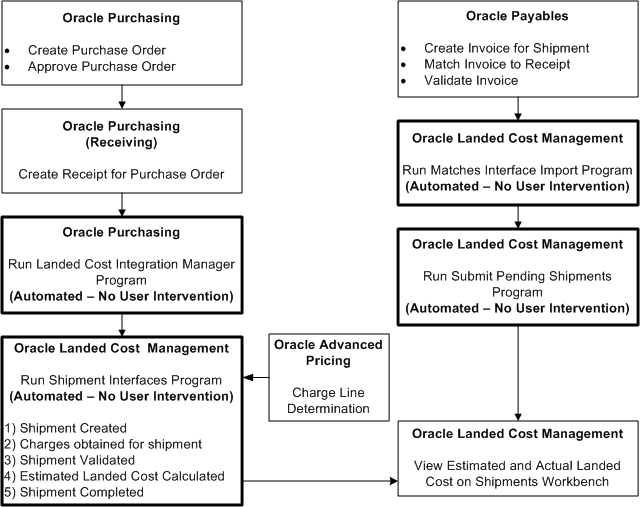
Oracle Landed Cost Management can be used as a service. In this scenario, after the receipt of items into inventory the Landed Cost Management shipment is automatically created. The estimation of the item landed cost is also automatically calculated based on the purchase documents price and the charge amounts given by Advanced Pricing.
All of the Landed Cost Management calculation and integration processes are performed using two concurrent programs (Landed Cost Integration Manager and Shipment Interfaces Import), which can be scheduled to run on a periodic basis in order to not require user intervention. Landed cost users will only access Oracle Landed Cost Management (Shipments Workbench) to view the estimated and actual landed costs for a Landed Cost Management shipment.
The actual landed cost calculation is based on the information collected from Payables invoices and is not changed in this scenario.
While viewing this cost information they can analyze and compare the difference between the estimated and actual landed costs. This information provides valuable insight into the costs of items.
Using the Shipments Workbench the estimated landed cost can be viewed for the shipment after the Landed Cost Integration Manager and Shipment Interfaces Import concurrent programs have completed successfully.
Then, after invoices are created and matched for the receipt of the item in Oracle Payables that actual landed cost information is passed to Landed Cost Management using two concurrent programs (Matches Interface Import and Submit Pending Shipments).
Finally, the Shipments Workbench can be accessed again to view the actual landed cost for the shipment after the Matches Interface Import and Submit Pending Shipments programs have completed successfully.
Landed Cost Management as a Service High-Level Process Flow
Following is a basic process flow when using Landed Cost Management as a service:
-
Create a purchase order for an item referencing an Inventory organization that does not have pre-receiving in LCM enabled using Oracle Purchasing.
Ensure that the Invoice Match Option field for each purchase order line is set to Receipt.
For information on creating a purchase order, see the Purchase Orders chapter in the Oracle Purchasing User's Guide.
-
Approve the purchase order.
For information on approving a purchase order, see the Approval, Security, and Control chapter in the Oracle Purchasing User's Guide.
-
Create a receipt for the items on the purchase order using Oracle Purchasing.
Important: If Landed Cost Management is implemented as a service application, then the receiving activities are initiated in Inventory Receiving and can be used for all items. If Landed Cost Management is implemented as a pre-receiving application, the user should not use Inventory Receiving for initiating the receiving activities.
For information on creating a receipt, see the Receiving chapter in the Oracle Purchasing User's Guide.
-
Run the Landed Cost Integration Manager concurrent program using Oracle Purchasing.
This program picks up purchase order receipt lines and sends them to the Landed Cost Management shipment interface tables.
Oracle recommends that this program be scheduled to run in the back ground with no user intervention required.
For more information, see Importing Estimated Landed Cost Information from Receiving.
-
Run the Shipments Interface concurrent program using Landed Cost Management.
This program picks up the Landed Cost Management interface lines and processes them into Landed Cost Management shipments. This concurrent program also calls routines for charge calculation, recovering taxes calculated for the purchase order lines, validation, landed cost calculation, and submission. This concurrent program uses the same APIs as the Shipments Workbench.
Oracle recommends that this program be scheduled to run in the back ground with no user intervention required.
For more information, see Importing Estimated Landed Cost Information from Receiving.
-
View the estimated landed cost that was calculated from the receipt information using the Landed Cost Management Shipments Workbench.
For more information, see Viewing Estimated Landed Cost for the Shipment.
-
Create an invoice for the receipt using Oracle Payables.
For information on creating an invoice, see the Invoices chapter in the Oracle Payables User's Guide.
-
Match the invoice to the receipts using Oracle Payables.
For information on invoice matching to receipts option see, the Invoices chapter in the Oracle Payables User's Guide.
-
Validate the invoices. After validation the actual invoice information is interfaced to the Landed Cost Management interface tables.
For information on validating see, the Invoices chapter in the Oracle Payables User's Guide.
-
Repeat Steps 14-16 for all other invoices (freight, insurance and so on) that pertain to the shipment.
-
Run the Matches Interface Import concurrent program using Landed Cost Management.
This program moves the matched information from Oracle Payables into the Landed Cost Management integration tables. This process also sets the Landed Cost Management shipments with Pending Matching field to Yes. At this time, the actual landed cost calculation has not been performed yet.
Oracle recommends that this program be scheduled to run in the back ground with no user intervention required.
For more information see, Calculating and Importing Actual Landed Cost for the Shipment.
-
Run the Submit Pending Shipments concurrent program using Landed Cost Management.
This program performs the submit process again and calculates the actual landed cost for the Landed Cost Management shipment. After this process completes successful you can view the actual landed cost using the Shipment Hierarchy and Landed Cost Detail pages in Landed Cost Management.
Oracle recommends that this program be scheduled to run in the back ground with no user intervention required.
For more information see, Calculating and Importing Actual Landed Cost for the Shipment.
After the actual estimated landed cost is calculated these steps occur:
-
Item cost adjustments for the item are created in Oracle Cost Management (difference between estimated and actual landed cost).
-
Accounting adjustment entries are created (difference between estimated and actual landed cost) by Oracle Cost Management.
If you are using Oracle Process Manufacturing (OPM), you must first run the Landed Cost Adjustments Import Process in OPM before these steps occur:
-
Item cost adjustments for the item are created in Oracle Process Manufacturing Cost Management (difference between estimated and actual landed cost).
-
Accounting adjustment entries are created (difference between estimated and actual landed cost) by Oracle Process Manufacturing Cost Management.
-
-
View the actual landed cost information for the shipment and compare the estimated landed cost to the actual landed cost for the shipment using the Landed Cost Management Shipments Workbench.
For more information see, Viewing Actual Landed Cost for the Shipment.
Importing Estimated Landed Cost Information from Receiving
In the Managing Landed Cost as Service flow the creation of landed cost shipments from purchase order receipts and the calculation of estimated landed cost for those shipments is performed by two concurrent programs (Landed Cost Integration Manager and Shipments Interface Import). These concurrent programs can be scheduled to run automatically in the back ground without user intervention. The Landed Cost Integration Manager program needs to be run first and then the Shipments Interface Import Program.
The Landed Cost Integration Manager concurrent program picks up purchase order receipt lines with a status of LC PENDING and sends them to the Landed Cost Management shipment interface tables and changes the status from LC PENDING to LC INTERFACED.
The Landed Cost Integration Manager concurrent program is owned by Oracle Purchasing and should be run by the appropriate responsibility in that application.
For more information on the Landed Cost Integration Manager, see the Oracle Purchasing User's Guide.
The Shipments Interface Import concurrent program picks up the pending Landed Cost Management interface lines and processes them into Landed Cost Management shipments. This concurrent program also calls routines for charges calculation, recovering taxes calculated for the purchase order lines, validation, landed cost calculation, and submission. This concurrent program uses the same APIs as the Shipments Workbench.
By default, the records are created in the Landed Cost Management Shipments Header interface table in a way that all tasks (get charges, get taxes, perform validation, calculate landed cost, and submit) are automatically performed for the interfaced data. If imported Landed Cost Management shipments do not pass the validation routine you will need to fix them through the use of the Shipments Workbench.
For more information on re-validating a shipment that is on hold, see Validating a Shipment.
The Shipments Interface Import concurrent program is owned by Oracle Landed Cost Management and should be run by the appropriate responsibility in that application.
Prerequisites
- Receipts have been created for the items on a purchase order.
- The Landed Cost Integration Manager concurrent program has been run.
To Run the Shipments Interface Import Program
-
Navigate to the Submit Request window.
The Submit a New Request window appears asking for the type of request you want to submit.
-
Select the Single Request option and click OK.
The Submit Request window appears.
-
Select Shipments Interface Import in the Name field.
The Parameters window appears.
-
(Optional) Enter a transaction Group ID and select an associated Operating Unit and click OK.
To run the program for all of the available data do not enter any parameters.
-
Click Submit.
-
Click No in the Decision window.
-
To see the status of the concurrent request, navigate to the Requests window.
The Find Requests window appears.
-
Click Find to view the status of all the requests.
The Requests window appears displaying all of the requests.
Searching for Automatically Created Shipments
After the estimated landed cost information is imported from Receiving and the shipment is automatically created you can then search for the shipment and view the estimated landed cost.
The Group Reference field is automatically populated with the Receipt Number in the case of using Landed Cost Management as a Service.
Use this procedure to search for automatically created shipments:
Prerequisites
- You have already imported the estimated landed cost information from Receiving.
To Search for Automatically Created Shipments
-
Navigate to the Shipments Workbench.
The Shipments Workbench appears with just the Inventory Organization field available for selection.
-
Select a Inventory Organization that does not have pre-receiving in LCM selected for it.
-
Click Go.
The complete Shipments Workbench appears.
-
Select the type of information you want to display at the bottom of the Shipments Workbench using the Display field. Values are:
-
Shipment
-
Line Group
-
Shipment Line
By default Shipment appears in the Display field.
Depending on the Display selection, the information that appears at the bottom of the Shipments Workbench will pertain to that display option. For example, if you select Shipment then fields related to shipments will appear in the table.
-
-
In the Find Shipments region, expand the Shipments section and enter the fields you want to search on. Enter any of the following fields:
Field Name Description Operating Unit Select an operating unit for the shipment. Receiving Location Select a receiving location for the shipment. Shipment Date Select or enter a shipment date. Shipment Type Select the type of shipment. Shipment Status Select the status of the shipment. Values are: -
Completed
-
Incomplete
-
On Hold
-
Validated
-
Validation Required
Shipment Enter the specific shipment number. Pending Matching Select this check box if you want to search for shipments that are pending invoice matching in Oracle Payables. Otherwise, you can select Go without entering any search criteria and all of the available shipments in the Inventory Organization will display.
-
-
In the Find Shipments region, expand the Line Groups section and enter the fields you want to search on. Enter any of the following fields:
Field Name Description Group Enter a specific line group. Group Reference When using Landed Cost as Service, enter the receipt number. Third Party Select a third party associated with a line group. Third Party Site Select a third party site associated with a line group. Source Type Select a source type. Value is: Purchase Order -
In the Find Shipments region, expand the Shipment Lines section and enter the fields you want to search on. Enter any of the following fields:
Field Name Description Third Party Select a third party associated with the shipment line. Third Party Site Select a third party site associated with the shipment line. Purchase Order, Release, Line, Schedule Select information pertaining to a purchase order. Shipment Line Type Select the shipment type for the line. -
In the Shipment Lines section, expand the Show More Search Options section and enter the fields you want to search on. Enter any of the following fields:
Item Field Name Description Item Select an item number. Description Enter a description for the item. Rev Select an item revision number. Supplier Item Select a supplier item. Receipt Details Packing Slip Select a packing slip number. Receiver Select an individual that is the receiver. Freight Carrier Select a freight carrier. Bills of Lading Select a bills of lading. Transaction Details Transaction Date From and Transaction Date To Select a transaction date range by using the from and to fields. Receipt Routing Select a receipt routing. Values are: Delivery and Inspection. Shipment Container Number Select a container number for the shipment. Truck Number Select a truck number for the shipment. Bar Code Label Select a bar code label for the shipment. -
Click Go.
All of the data that matches the search criteria displays at the bottom of the Shipments Workbench in a table format. Depending on the Display option that was selected, different columns of data will appear in the table. Data will be related to Shipments, Line Groups, or Shipment Lines.
Viewing Estimated Landed Cost for the Shipment
After the shipment is automatically created you can then go and view the estimated landed cost for the shipment.
Use this procedure to view estimated landed cost:
To View Estimated Landed Cost for the Shipment
-
Navigate to the Shipments Workbench.
The Shipments Workbench appears.
-
Search for shipments that were automatically created.
For more information, see Searching for Automatically Created Shipments.
Shipments Workbench

All of the data that matches the search criteria displays at the bottom of the Shipments Workbench in a table format. Depending on the Display option that was selected, different columns of data will appear in the table. Data will be related to Shipments, Line Groups, or Shipment Lines.
-
Navigate to the Shipment Hierarchy page using one of these methods:
-
-
Select the shipment in the table on the Shipments Workbench.
-
Select View Landed Cost in the Actions field.
-
Click Go.
-
-
-
Select the Shipment link in the table for a shipment on the Shipments Workbench.
The View Shipments page appears.
-
Select View Landed Cost in the Actions field.
-
Click Go.
-
Shipment Hierarchy page

The Shipment Hierarchy page appears displaying the estimated landed cost for each shipment, line group, and line.
The hierarchy for the shipment is as follows:
-
At the top of the hierarchy is the Shipment itself. Depicted with a Component Number equal to the shipment number and a Component Type of shipment.
-
Next is the line group for the shipment. Depicted with the Component Number equal to the line group number and a Component Type of Line Group.
-
After that is the shipment line. Depicted with the Component Number equal to the shipment line number and a Component Type of Shipment Line. At this level the total estimated landed cost is displayed for the shipment line in the Estimated Amount column and the unit estimated landed cost is displayed in the Unit Landed Cost column. The Estimated Amount is the sum of all allocation amounts for a shipment line.
-
Finally, under each shipment line is the shipment line, charge line, and tax line allocations. Depicted with a Component Type equal to Shipment Line Allocation, Charge Line Allocation, or Tax Line Allocation and the specific cost factor displayed in the Component Reference field.
Note: The Billed Amount, Actual Amount, and Actual History columns do not appear on this page until after the invoice is received and matched in Oracle Payables.
-
-
To view landed cost details, click the Unit Landed Cost link for a shipment line.
Landed Cost Details page

The Landed Cost Details page appears displaying the break down for the total estimated landed cost for the shipment and for the estimated unit landed cost. The cost factor (analysis code and component class) display for each line in the break down.
At the bottom of the page these charts display:
-
Pie Graph: The pie graph displays the total allocation percentage for each cost that make up the shipment line.
-
Bar Graph: The bar graph displays the total allocation amount for each cost in the shipment line.
-
Calculation History: This graph displays the landed cost adjustment calculation history for the unit landed cost.
When only estimated landed cost has been calculated this chart will display just as individual points on the graph. After actual landed cost is calculated, you will be able to view lines in this graph that depict the calculation history.
-
Calculating and Importing Actual Landed Cost for the Shipment
Before you can view the actual landed cost for a shipment in Landed Cost Management a couple of concurrent programs (Matches Interface Import and Submit Pending Shipments) need to be executed. When using Landed Cost Management as a Service, Oracle recommends that these programs be scheduled to run periodically without any user intervention.
The Matches Interface Import program is responsible for importing the matched invoice information from Oracle Payables into Landed Cost Management. During this program execution, all shipments that need to be resubmitted that are being impacted by the capture of actual amounts will be set as “Pending” shipments. Pending Landed Cost Management Shipments must be resubmitted, so that a new landed cost can be figured out as “actual landed cost” and the differences between estimated and actual landed costs can be sent to Oracle Cost Management.
Pending Landed Cost Management shipments can be submitted through the Submit Pending Shipments concurrent program. The Submit Pending Shipments program calculates actual landed cost and then performs the submitting action again for the shipment. All of the routines necessary to recalculate landed costs and generate the Oracle Cost Management integration transactions are performed.
Use these procedures to calculate and import the actual landed cost:
Prerequisites
- Invoices have already been created in Oracle Payables for the item and charges (insurance, freight and so on) associated with the shipment. Plus, the invoices have been matched and validated.
To Run the Matches Interface Import Program
-
Navigate to the Submit Request window.
The Submit a New Request window appears asking for the type of request you want to submit.
-
Select the Single Request option and click OK.
The Submit Request window appears.
-
Select Matches Interface Import in the Name field.
-
Click Submit.
-
Click No in the Decision window.
-
To see the status of the concurrent request, navigate to the Requests window.
The Find Requests window appears.
-
Click Find to view the status of all the requests.
The Requests window appears displaying all of the requests.
To Run the Submit Pending Shipments Program
-
Navigate to the Submit Request window.
The Submit a New Request window appears asking for the type of request you want to submit.
-
Select the Single Request option and click OK.
The Submit Request window appears.
-
Select Submit Pending Shipments in the Name field.
The Parameters window appears.
-
(Optional) Enter an Inventory Organization or an Inventory Organization and a Shipment Number and click Go.
To run the program for all of the available data do not enter any parameters.
-
Click Submit.
-
Click No in the Decision window.
-
To see the status of the concurrent request, navigate to the Requests window.
The Find Requests window appears.
-
Click Find to view the status of all the requests.
The Requests window appears displaying all of the requests.
Viewing Actual Landed Cost for the Shipment
Using the Shipment Hierarchy and Landed Cost Details pages you can view the actual landed cost for a shipment. These pages itemize all of the allocation values that make up the total landed cost.
Using the Actual Matching History page you can view the detailed invoicing history for the shipment line.
Plus, you can view the proportion of each landed cost component making up the total landed cost in a Pie Chart or Bar Graph and the unit landed cost calculations in the Calculation History graph.
Use this procedure to view actual landed cost for the shipment:
Prerequisites
- Invoice information related to the Landed Cost Management shipment has been imported from Oracle Payables.
- Actual landed cost has been calculated for the shipment.
To View Actual Landed Cost for the Shipment
-
Navigate to the Shipments Workbench.
The Shipments Workbench appears.
-
Search for shipments that were automatically created.
For more information, see Searching for Automatically Created Shipments.
Shipments Workbench
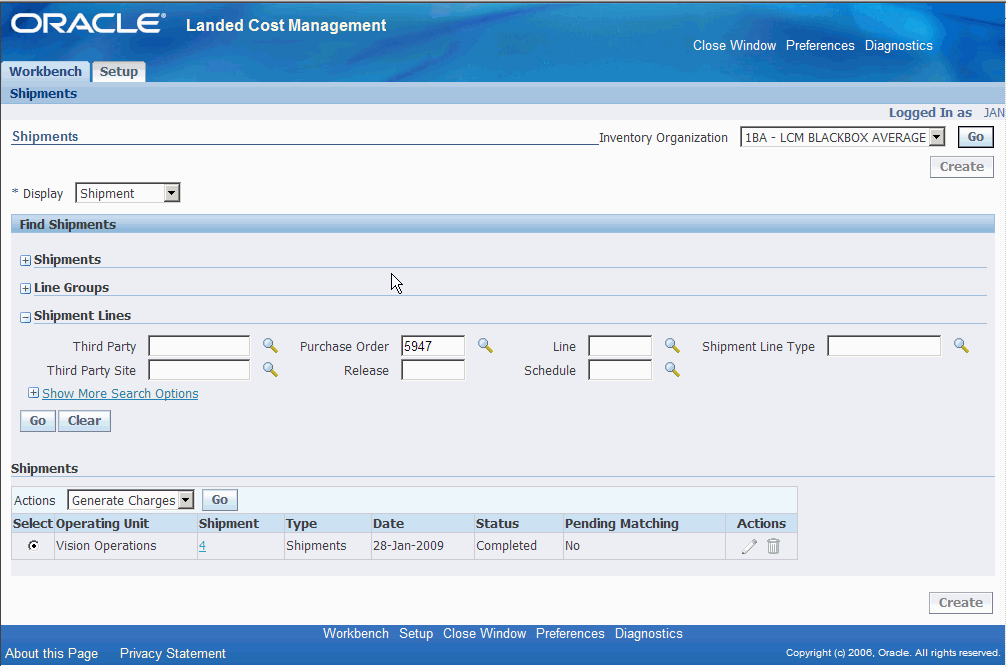
All of the data that matches the search criteria displays at the bottom of the Shipments Workbench in a table format. Depending on the Display option that was selected, different columns of data will appear in the table. Data will be related to Shipments, Line Groups, or Shipment Lines.
-
Navigate to the Shipment Hierarchy page using one of these methods:
-
-
Select the shipment in the table on the Shipments Workbench.
-
Select View Landed Cost in the Actions field.
-
Click Go.
-
-
-
Select the Shipment link in the table for a shipment on the Shipments Workbench.
The View Shipments page appears.
-
Select View Landed Cost in the Actions field.
-
Click Go.
-
-
-
Select View Landed Cost in the Actions field and click Go.
Shipment Hierarchy page
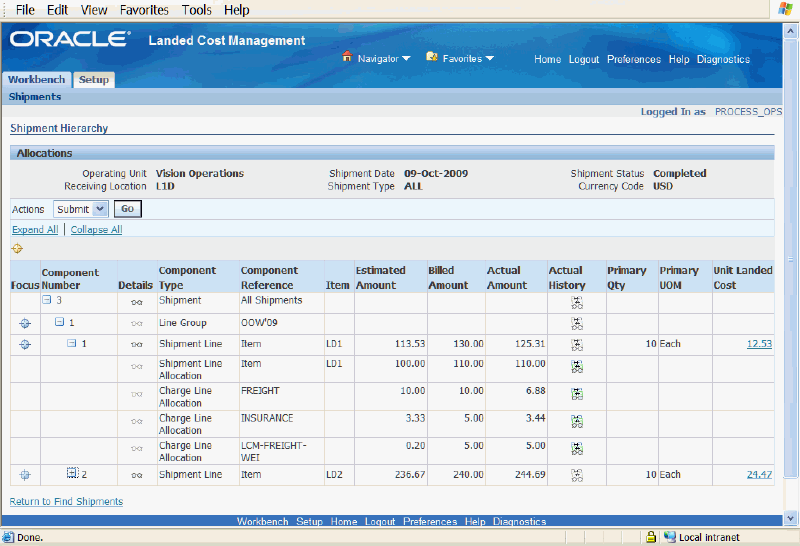
The Shipment Hierarchy page appears displaying the actual landed cost for each shipment, line group, and line.
The Billed Amount, Actual Amount, and Actual History columns appear on this page after the invoice is received and matched in Oracle Payables and then the actual landed cost is calculated and imported to Landed Cost Management for the shipment. The actual amount columns are next to the Estimated Amount column so that the difference between the estimated and actual landed cost are easily viewed.
The hierarchy for the shipment is as follows:
-
At the top of the hierarchy is the Shipment itself. Depicted with a Component Number equal to the shipment number and a Component Type of shipment.
-
Next is the line group for the shipment. Depicted with the Component Number equal to the line group number and a Component Type of Line Group.
-
After that is the shipment line. Depicted with the Component Number equal to the shipment line number and a Component Type of Shipment Line. At this level the actual landed cost is displayed for the shipment line in the Actual Amount column and the unit actual landed cost is displayed in the Unit Landed Cost column. The Actual Amount is the sum of all allocation amounts for a shipment line.
-
Finally, under each shipment line is the shipment line, charge line, and tax line allocations. Depicted with a Component Type equal to Shipment Line Allocation, Charge Line Allocation, or Tax Line Allocation and the specific cost factor displayed in the Component Reference field.
-
-
To view the detailed invoicing history, click the View Actual History icon in the Actual History column next to an allocation line.
Note: The Actual History icon is only available for each allocation line. It is not available for the shipment, line group, or shipment lines levels.
Actual Matching History page
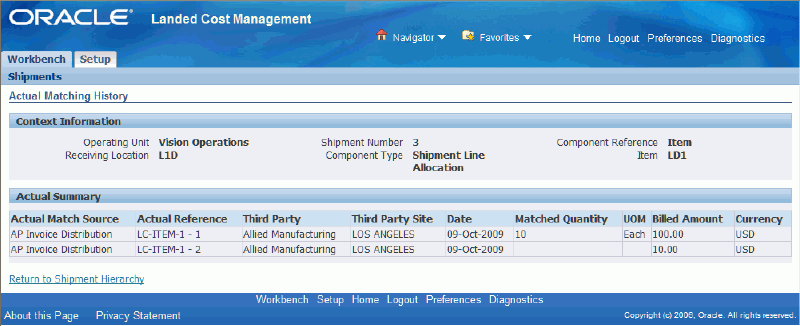
The Actual Matching History page appears displaying the details for the invoice history. The Actual Reference column displays the invoice number plus the distribution number.
-
To view landed cost details, click the Unit Landed Cost link for a shipment line.
Landed Cost Details page
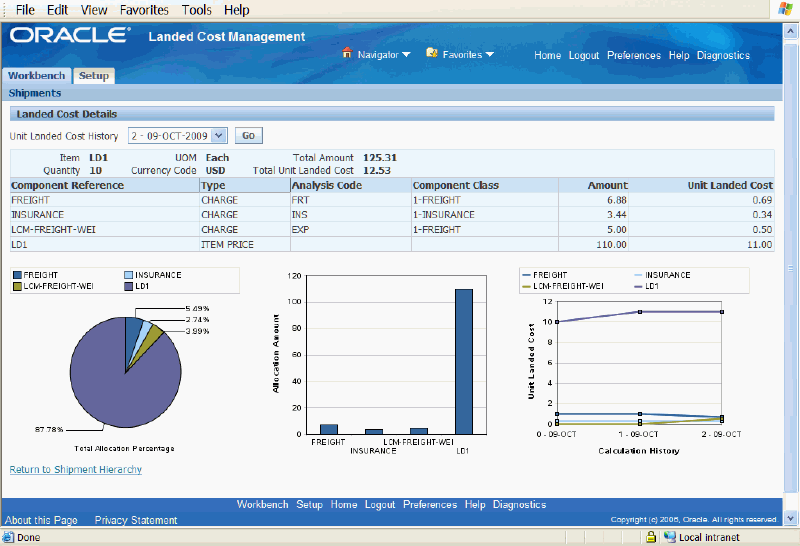
The Landed Cost Details page appears displaying the break down for the total actual landed cost for the shipment and for the actual unit landed cost. The cost factor (analysis code and component class) display for each line in the break down. The latest landed cost adjustment details appear by default.
At the bottom of the page these charts display:
-
Pie Graph: The pie graph displays the total allocation percentage for each cost that make up the shipment line.
-
Bar Graph: The bar graph displays the total allocation amount for each cost in the shipment line.
-
Calculation History: This graph displays the landed cost adjustment calculation history for the unit landed cost.
-
-
(Optional) Select another cost adjustment using the Unit Landed Cost History field. The values that appear for the field are equal to the Adjustment Number from the shipment line plus the date it occurred.
The system refreshes the page displaying the details for that cost adjustment. The Pie Chart and Bar Graph refresh with the new information but the Calculation History graph stays the same.